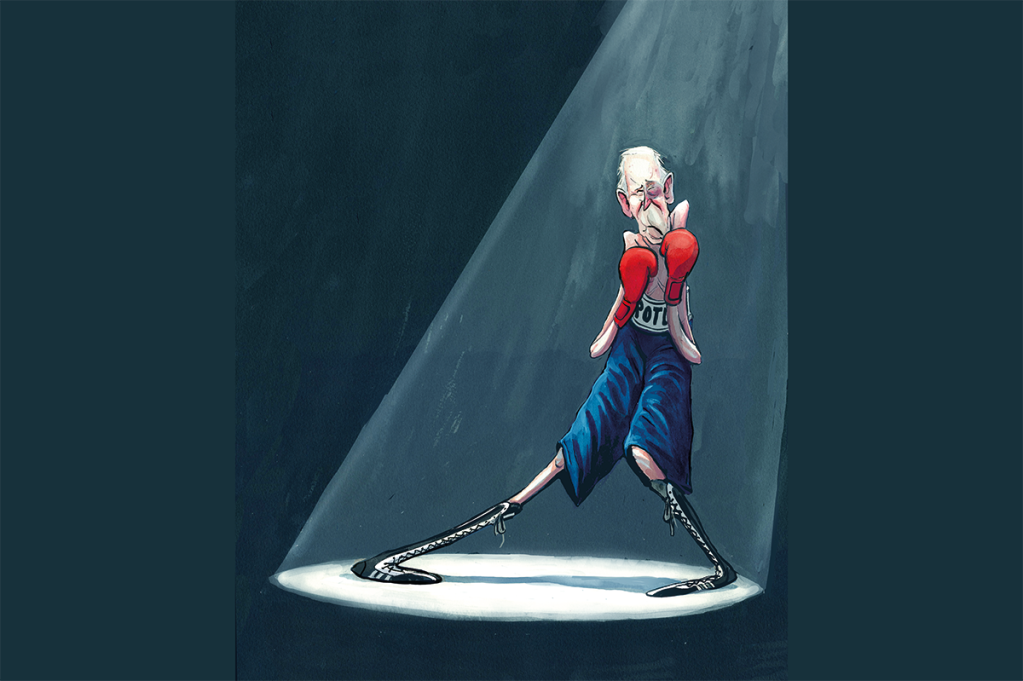At the start of the year, largely thanks to the actions of the president, the Republican Party was sitting pretty. It would be generous to say that Joe Biden’s first year in office didn’t live up to expectations. The former vice president who was heralded by his party and the liberal media as the man who would return the country to normalcy, restore faith in government institutions and protect democracy instead created new post-pandemic chaos. Biden and the Democrats failed to deliver in pretty much every area that mattered to Americans: gas prices, inflation, supply chains, the southern border, Afghanistan, Covid-19 and crime. National polls reflected the mood; Biden’s approval rating in January 2022 sat in the low forties and congressional Democrats were trending even lower.
Things seemed ripe for Republicans to ride a “red wave” that would return them control of the House and the Senate. But now, with campaign season in full swing, the GOP’s enthusiasm advantage has all but disappeared. By mid-August, Senate Minority Leader Mitch McConnell was publicly tempering expectations as Republican candidates struggled in key battleground states. Polls at the time had Mehmet Oz down double digits to John Fetterman in Pennsylvania and Blake Masters back about ten points behind incumbent Mark Kelly in Arizona. Hillbilly Elegy author J.D. Vance was holding on to a slim lead in Ohio, former pro football player Herschel Walker was up a few points on Georgia incumbent Raphael Warnock and Ted Budd in North Carolina was in a dead heat with opponent Cheri Beasley.
If just a couple of these races flip the wrong way, it could dash Republican hopes of winning the Senate. How could things possibly be this close? Is the red wave going to be little more than a ripple?
If you ask Democratic strategists how they’ve managed to make up so much ground, they will likely tell you that the Supreme Court’s decision to overturn Roe v. Wade changed the entire tenor of the midterms. Rather than the race being a referendum on the economy and the Biden administration, voters are now heavily motivated by protecting access to abortion. The polls tell a different story. Despite a majority of Americans opposing the Dobbs decision, abortion is still lucky to crack voters’ top five most-important issues. Democrat Terry McAuliffe tried to use abortion as a wedge issue during the 2021 gubernatorial election in Virginia, wasting millions on ineffective TV ads against eventual winner Glenn Youngkin.
“[Dobbs] has changed things to some degree. I don’t think you can argue that it hasn’t. But I think ultimately that this is still going to be an election that is decided on economic issues and on the approval of voters for the president,” Jim Hobart, a Republican consultant and partner at Public Opinion Strategies, told me. “When you look at the voters who decide elections, who are independent voters, the Democrats’ numbers and President Biden’s numbers with independents are still very, very bad.”
Meanwhile, even before voting has started, the Republican Party faces something of a civil war over who is to blame for their candidates’ poor performance.
The Trump-aligned right blames Mitch McConnell, arguing that he holds a grudge against populists. The minority leader, they claim, is deliberately withholding money from the “America First” faction of the GOP as punishment for defeating establishment picks in the primaries. McConnell dumped fuel on this fire when he questioned the “quality” of candidates running in statewide races this summer.
“I think there’s probably a greater likelihood the House flips than the Senate. Senate races are just different,” the GOP leader said at a Northern Kentucky Chamber of Commerce luncheon in mid-August. “Candidate quality has a lot to do with the outcome.” The McConnell-aligned Senate Leadership Fund then pulled $10 million in ad buys for Blake Masters out of Arizona. This was further proof to the new right that McConnell was not dedicated to a Republican majority.
However, GOP insiders tell me that McConnell’s “candidate quality” comment was likely a reference to his personal frustrations with Dr. Oz, who spent the better part of the spring and summer running a lazy campaign built around little more than name identification. The simpler and more persuasive explanation for the SLF decision to pull money from Arizona isn’t bad blood between McConnell and Masters, but the reality that scarce resources must be efficiently distributed if the GOP is to secure a majority in November.
“Arizona is an expensive state with a candidate who has no money, with a late primary up against an incumbent that reliably polls between 49 and 51 and who has $50 million. This is not difficult math. It’s not emotional. It’s not sentimental,” one Republican campaign strategist explained to me. “Blake Masters is the fifty-third or fifty-fourth seat. McConnell is focused on the forty-seventh through fifty-second.”
“We’re leaving the door wide open in Arizona, but we want to move additional resources to other offensive opportunities that have become increasingly competitive, as well as an unexpected expense in Ohio,” Senate Leadership Fund president Steven Law told Politico. This explanation makes sense when you consider that SLF dumped $28 million more into the Ohio race in August. This massive investment was of course going to affect spending elsewhere, and if McConnell truly hated populist candidates, why would he be spending tens of millions on Vance?
Further, McConnell tried to avoid hanging Masters out to dry. According to the Washington Post, the GOP leader called Silicon Valley billionaire Peter Thiel to see if he would be willing to split costs on the Arizona race or cover the ad buys SLF pulled in August. McConnell acknowledged that the Ohio race was becoming costlier than expected. Thiel, a friend of both Vance and Masters who invested significant dollars into their primary campaigns, declined to get further financially involved in Arizona.
The finger-pointing at McConnell, several Republican strategists I spoke to argue, misses the real villain of the campaign cycle: Rick Scott.
Insiders say that Scott, the National Republican Senatorial Committee chair, has simply failed to raise enough money to support candidates in key races, forcing SLF to pick up the slack. The NRSC spent a huge chunk of its money — $40 million — early in the midterm season, leaving candidates without a financial lifeline in the homestretch. Last year, Scott gambled on investing millions in a digital fundraising program, which only worked briefly before crashing and burning.
“They dumped tens of millions of dollars into a small-dollar texting program that has clearly just come up a dry socket. So they’re broke. They don’t have half as much cash on hand as the Democratic counterpart,” a source with knowledge of NRSC finances told me.
As the committee faced financial trouble, Scott took a two-week vacation to Italy to celebrate his fiftieth anniversary with his wife. He defended the ill-timed trip, noting it had been planned a year in advance, but critics still slammed him for seemingly abandoning the GOP in its time of need. The attacks on McConnell, sources suggested to me, were a way for the NRSC to cover for Scott’s dereliction of duty.
The Florida senator indeed poked at McConnell for questioning the quality of Republican senatorial candidates — and has previously flouted the minority leader’s approach to the midterms by releasing his own policy platform for a Republican-led Senate. “Senator McConnell and I clearly have a strategic disagreement here… We have great candidates,” Scott said in early September. “He wants to do the same thing I want to do: I want to get a majority. And I think it’s important that we’re all cheerleaders for our candidates.”
Scott is surely right that it is probably counterproductive for McConnell to publicly trash the party’s candidates. However, he doesn’t have much room to complain if it is true that he has run the NRSC’s finances into the ground.
Despite all the internal chirping, Republicans still have reason to be optimistic. There is plenty of time to get back to basics: voter registration, on-the-ground campaigning and an aggressive approach to earned media. Voter registration, in particular, promises to be a huge boon, as demonstrated in Florida: when Governor Ron DeSantis took office in 2018, Democrats outnumbered Republicans by 300,000. Now Republicans have a 250,000-voter advantage. Races in Pennsylvania and Arizona have tightened considerably — and the GOP is currently enjoying a post-August fundraising bump.
“There’s always a lot of finger-pointing. I get it, folks are frustrated, but the reality is people have to run good, solid campaigns,” says a senior campaign official in North Carolina. “We don’t have to make it real complicated.”
Perhaps most importantly, the president is still historically unpopular. Biden, the face of the Democratic Party, is badly bruised after his first year and a half in office. And, even among Democratic voters, a majority don’t want him to run again in 2024. The GOP should still be able to deliver a knock-out blow to unified Democratic government. And if they don’t, there will be plenty of time for blame games.
“If in February of 2021, someone came to you and said, ‘Hey, Joe Biden’s approval rating is going to be 42 percent going into Labor Day of 2022, is that going to be good for Republicans?’” asks Hobart rhetorically. “The answer would be it’s going to be a really good night for Republicans.”
This article was originally published in The Spectator’s October 2022 World edition.

























